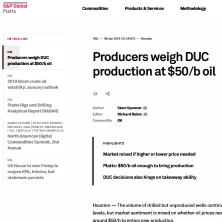 Producers weigh DUC production at $50/b oil
Producers weigh DUC production at $50/b oil
Highlights
- Market mixed if higher or lower price needed
- Platts: $50/b oil enough to bring production
- DUC decisions also hinge on takeaway ability
Houston — The volume of drilled but unproduced wells continues to build across the US to record levels, but market sentiment is mixed on whether oil prices need to continue to recover from levels now around $50/b to entice new production.
As the price of oil began to slip early in Q4 2018 from the mid-$70s/b, many upstream operators projected they would begin producing their DUC inventory in early 2019. But oil has since slid to mid-2017 levels and producers’ views may have changed.
On Wednesday, front-month WTI crude futures settled at $52.36/b, up $2.58 on the day, as prices continued to climb for a recent low of $44.61/b December 27.
While crude prices have trended higher, market-watchers are mixed on what will induce operators to begin producing banked wells.
“You’ve got a tug of war of forces,” said Tom Petrie, head of boutique oil and gas investment bank Petrie Partners.
“The lower oil price raises some questions about whether you go ahead with completing these wells,” Petrie said. “Some companies want to get them in a producing mode; others say they won’t get an adequate return right now, so they’ll wait.”
Operators consider DUC production a bargain. Roughly 30%-40% of a well’s total cost is drilling, so paying less when it comes time to produce is an attractive prospect, especially when oil prices are lower and they want to maximize cash flows.
If 2019 oil prices are weak, “DUCs will likely have extra significance in helping [operators] maintain or grow production volumes,” said, Sami Yahya, an analysts with S&P Global Platts Analytics.
Even though the DUC count rose last year, some companies may have begun completing and producing their banked well inventories before oil prices dropped, said Rob Thummel, managing director at investment consultants Tortoise Capital Advisors.
Thummel noted US oil production in 2018 was larger than expected and the oil rig count also rose last year, but not enough to support such a large output growth spurt.
As a result, “there had to be a lot of DUCs completed” last year, Thummel said. “That may have been part of why we were able to grow production so much. It’s not as if [individual] wells produced much more than anticipated.”
Evercore ISI noted in its 2019 Global E&P Spending Outlook released last month E&P operators drilled more than 15,000 wells in seven major US shale basins during the previous year, but completed less than 13,000 as DUC inventory increased by nearly 30%.
Lower oil prices might trigger a round of DUC completions because producers want revenues, Thummel said.
“Generating free cash flow is really important for a lot of producers to bring investors into their stocks,” Thummel added. “DUCs could play a key role in that, since companies don’t have to spend as much capital on already-drilled wells.”
Bringing on DUCs is more cost-effective than drilling a new set of wells, Platts Analytics analyst Andrew Cooper said. Consequently, “$50/b oil in each of the major [US] basins should be sufficient for bringing these DUCs into production,” he added.
Read the rest here: https://www.spglobal.com/platts/en/market-insights/latest-news/oil/010919-producers-weigh-duc-production-at-50-b-oil
